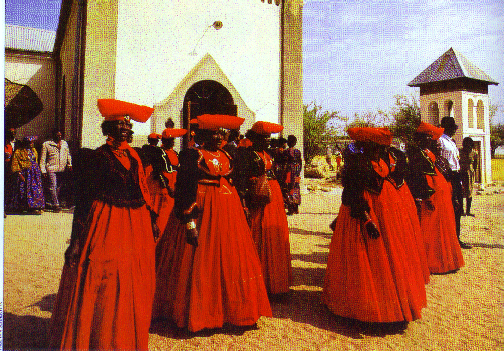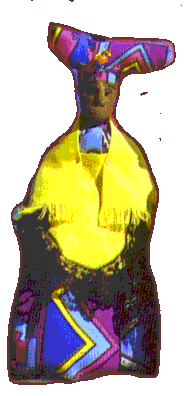|
|
|
African Dolls
![]()

Herero women in traditional dresses at the Herero Festival
The Herero - History
The Herero are a pastoral cattle-breeding people who migrated to Namibia several centuries ago. According to oral tradition they moved down from the great lakes of East Africa and later crossed into presend-day Zambia and southern Angola, arriving at the Kunene River in about 1550. It is believed that they formerly lived in a country with water and reeds, known as Roruu, before migrating further south. No one has, however, succeeded in tracing this African marshland.
After inhabiting Kaokoland for some 200 years, a large number of Herero migrated further south, leaving the Himba and Tjimba tribes behind, and reaching the Swakop River valley towards the middle of the 18th century. During the 19th century they moved eastwards, eventually establishing themselves in the northern central areas of the country.
Today the Herero number over 100 000. They can be subdivided into the following groups: The Herero proper, with traditional chiefdoms Maharero (Okahandja), Zerua (Omaruru) and Kambazembi (Waterberg); the Ndamuranda; the Tjimba Herero of Kaokoland (Kunene Region); the Mbanderu, who live in the east of Namibia, especially in the Gobabis district and the reserves of Epukito, Otjombinde and Aminuis; the Himda; and other smaller factions in northern Kunene and south-western Angola.
The colonial wars and Herero Uprising of 1904 - 1905 resulted in a drastic decrease of the Herero population. Under General Lothar von Trotha and his infamous Vernichtungsbefehl (proclamation of extermination), the most shameful war atrocity in Namibia's history was commited. By December 1905, when an armistice was signed between the warring parties, only 16 000 Hereros of an estimated 80 000 were still alive. However, despite the suppressing of their traditional culture, confiscation of tribal lands and the restrictions of labour laws, the Herero managed to keep their bonds of family life, tribal solidarity and national consciousness alive, as is demonstrated by the annual Herero Festival on Maharero Day in August when various units of paramilitary organisations parade before their leaders in full dress through the streets of Okahandja, Gobabis and Omaruru

African doll as produced by local women in Namibia
The Herero - Doll
The doll is approximately 50cm in length and weighs less than a kilogram.
If you are interested, please
email us.
This page has been created on 10 April 2000
This page has been updated on 26 April 2000